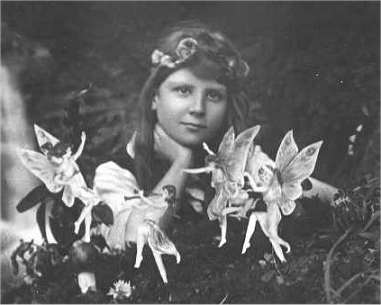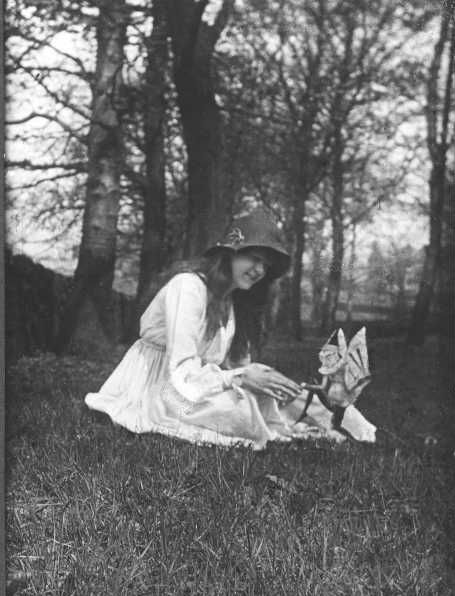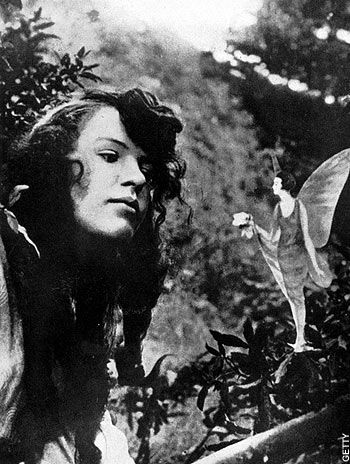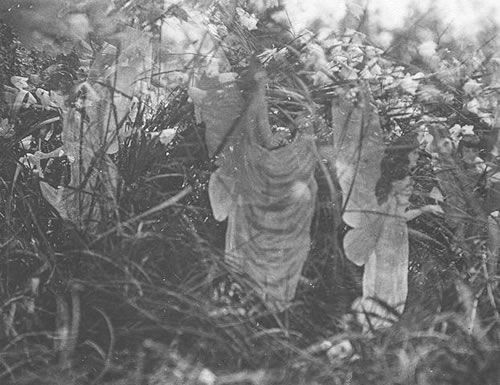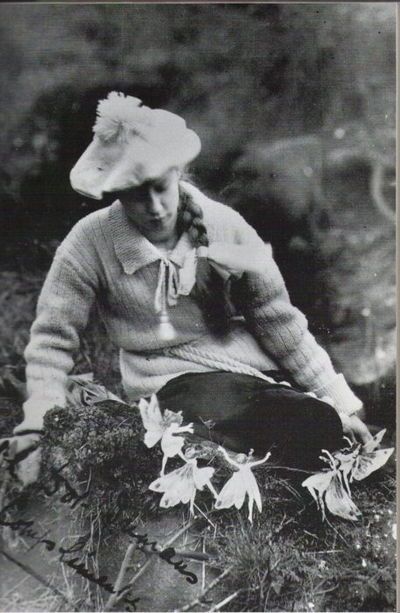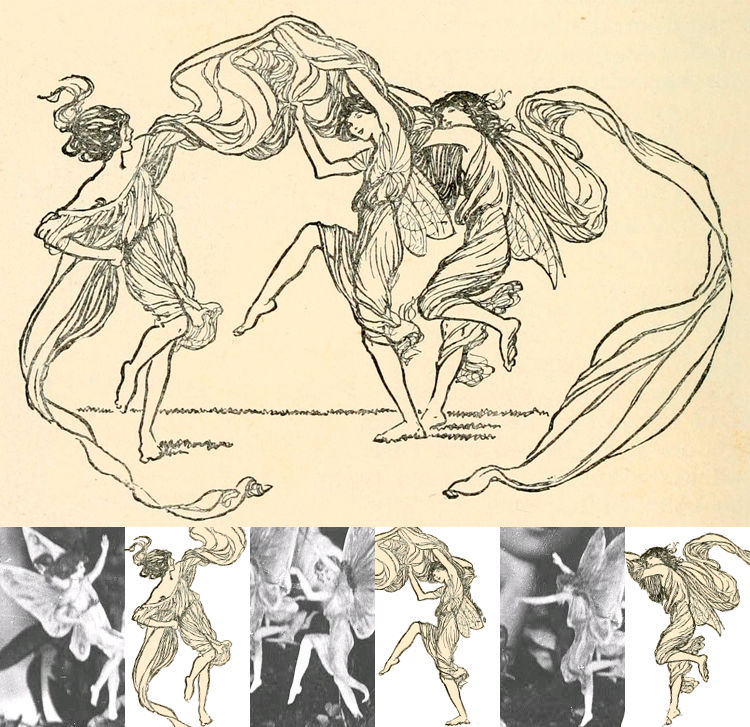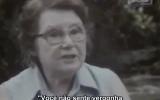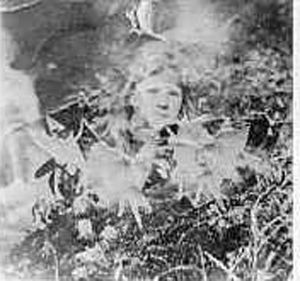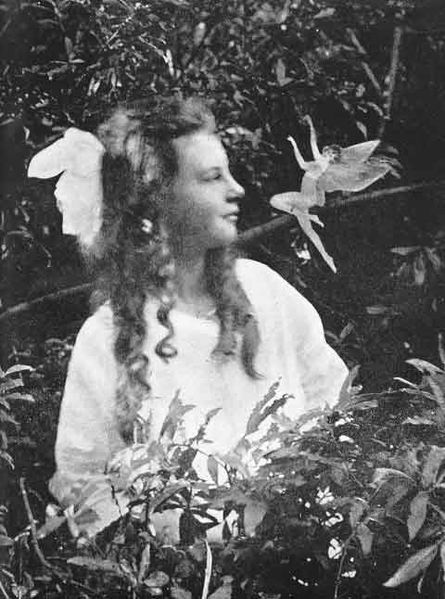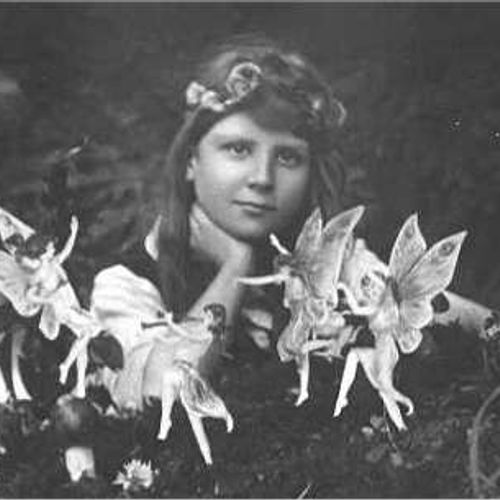
| Added | Wed, 17/01/2018 |
| Источники | |
| Феномены | |
| Версии |
This story started in the spring of 1917 in the village of Cottingley (Yorkshire, England), which is located between the towns of Shipley and Bingley. This village at that time was a small village of 142 houses and 6 farms, located on three streets. There was a house with a small garden, in which lived two cousins, Elsie Wright (Elsie Wright) and Francis Griffiths (Frances Griffiths). In the vicinity of this village and was received by the famous photographs of fairies, which caused a lot of noise and still causing heated debate.
A series of five photographs were taken in the girls, the period between 1917 and 1921. At the time of shooting Elsie was sixteen years old, and her cousin, Francis ten.
The sisters loved to play in the Creek Cottingley occurring outside the village. One day in the spring of 1917, the mother of Elsie asked why they spend there all free time, the girls said that playing with the fairies. Adults, of course, did not believe the children. Then Elsie begged father's camera (expensive at the time the camera "Midge") and glass plates for photography (the company "Imperial Rapid") and took the first photograph of the series, which later became the most famous. She made about 3 o'clock in the afternoon, the distance to the object is about 4 feet, exposure is 1.50 seconds. Aperture of f/11.
Father, show photographs, suspected that the fairies were cut out of paper, but found neither the Creek nor the girls in the wastebasket scraps, confirming his hunch.
The second time the camera girls entrusted in October, after which the light appeared a second picture next to Elsie was the little gnome. The picture was taken on a Sunny day with a few clouds about 4 o'clock in the afternoon. The distance to the object is 8 feet extract is 1.50 seconds, aperture of f/11. The picture was quite pale, since ten years, Francis pulled the trigger too early. After that the camera was broken and my dad won't let the girls take the camera. However, exactly as long as the story was not made public.
Downloads images acquired thanks to his mother Elsie, which he attended lectures at the Theosophical society of Bradford, considering that it has astral vision and memory of past lives. On one of lectures on "the little people", she mentioned that her daughter and niece managed to photograph fairies, and showed two pictures. The lecturer was interested in this case, and those that fall went to a Theosophical conference in Harrogate, and finally in the beginning of next year fell into the hands of Edward L. Gardner (Edward L. Gardner), the Manager of the company. He sent pictures in the London magazine the Strand Magazine. Publication in the journal drew attention, in particular, Arthur Conan Doyle, keenly interested in spiritualism and fairies. Later, he contacted the girls and their families to learn more.
Below are two letters written by Doyle: the first Elsie, the second to her father. Other letters can be seen here.
Conan Doyle sent the pictures sent to him for examination physics Oliver Lodge and photographer Fred Barlow. Both viskazali doubts about the authenticity of the fairies, captured girls. Despite this, Doyle included the retouched images in your article.
The girls themselves, as well as their mother, made no secret of their photos and sent copies to friends. As example an excerpt of a letter to Johanna Parvin, her friend from South Africa, dated 9 November 1918 (it was found in 1922 and first published in the newspaper "Cape town Argus" November 25, 1922):
I learn in school French, geometry, cookery and algebra. Last week dad came back from France, he was there ten months and we all hope that in a few days the war will be over... Sending you two pictures of me at first – me in my swimsuit in the backyard for a second – I'm with the fairies near the stream, this shot Elsie.
(I am learning French, Geometry, Cookery and Algebra at school now. Dad came home from France the other week after being there ten months, and we all think the war will be over in a few days... I am sending two photos, both of me, one of me in a bathing costume in our back yard, while the other is me with some fairies. Elsie took that one.)
Edward Gardner in July went to Cottingley, where the girls again confirmed that they had seen fairies, and expressed willingness to take a few more pictures to prove his innocence. In August 1920, Gardner gave them the camera "Cameo" with 20 plates, which were not visible to an outsider label.
At this point, the press had published numerous articles, and the journalist of "The Westminster Gazette" personally spoke with the girls and came to the conclusion that the photos had captured something inexplicable.
The girls also received from Gardner's camera was able almost immediately to make three more pictures. Characteristics of the images: camera "Cameo", a distance of 3 feet, exposure is 1.50 seconds, aperture of f/11.
The last picture they did, dropping the camera in the tall grass and pulling the stopper attached to it with gum.
Doyle and Gardner, having received the plates, checked standing on their labels. Seeing that the plates are replaced, they sent them to the examination of well-known photographers. Those, in turn, has given the conclusion that the double exposure and retouching on the plate there that was made public for the recognition of the authenticity of the photos.
However, many people were convinced that all this is a hoax. In particular, when Conan Doyle wrote that girls have great mediumistic force, and Francis also can unconsciously distinguish some ectoplasm, allowing the fairies to materialize, the leaders of the "Society for the study of the psyche", in which Doyle was from 1891, has publicly stated that the authenticity of the photos in question and that this expression only the private views of the author.
Despite the hype around the story and the flow of visitors to the Creek Cottingley, nor the girls, nor anyone else no longer able to take photos of the fairies (although, for example, a clairvoyant Geoffrey Hodgson saw one of them "on the astral level").
But editors of Newspapers and magazines have received many new eyewitness accounts of the appearances of the fairies in Europe and the United States. The most famous case are the observations of Dorothy Inman. She not only said that they had seen fairies, and has provided evidence in the form of photos taken in 1922.
Also was sent to the gnome, made in 1927, some Ele Arnim from Germany, and pictures of fairies from Gloria Ramsey of the town of La JOLLA in California, which has seen them not only at home, but in the English Cornwall.
The story died down and was forgotten until 1978, the photos did not attract the attention of James Randi, known for his numerous disclosures of various charlatans and scams. He enlarged the photos and noticed the threads holding the fairies, and was mentioned in his book "Trickery and deceit!". Elsie answered him with an open letter published in the magazine New Scientist, where, not without irony inquired to what part of the sky is attached to the strings, and in this case it was possible to keep the "paper" fairies in one position.
In 1971, Elsie and Frances gave their first interview to the BBC, but despite the persistence of journalists, the hoax confessed.
In September 1976, the correspondent of the Yorkshire television company Austin Mitchell also took interview them. In it Elsie claimed that "the photos were real, and no tricks with them, she did not, although won't swear on the Bible that there really were fairies".
Later, in a letter to journalist Brian CoE she said a little differently: "in terms of photos, we with Francis believe that they were fragments of our imagination."
The solution of this case found the British writer Fred Gettings in 1978. He found a children's book – "Book of gifts Princess Mary," published in 1915 with illustrations by Arthur Shepperton. One of the pictures in the book is remarkably reminiscent of fairies with photographs Elsie and Frances.
Following this discovery, the sisters in an interview adhering to the other items. Now they insisted that they had seen real fairies, but because photographing them was impossible, they decided to use the illustrations from the book, like those of the fairies, make a few drawings, and then photographed. This version sounded in interview to transfer "Neponyatnoe" (The Unexplained) in English BBC in 1981 and 1982.
A year later, in 1983, publisher of the journal "the British Journal of Photography" Jeffrey Crowley published an article in which he claimed that Elsie and Frances confessed to the fraud. According to him, Elsie agreed that "is the age when you need to tell the truth."
Fairies, copied from the book were cut from paper and held on the pins for hats, and gnome Elsie molded from clay.
Oh, how my sister and I had fun reading about webbed handles fairies! recalled Elsie. — Actually we didn't know how they should be cut.
According to Crowley, Elsie demonstrated how long the studs have passed approximately through the middle of the figures and then stuck into the ground or into a suitable thick branch.
If not then the fashion to pin hats, — she said, — there would be no fairies of Cottingley. I never thought of cheating our Elsie trick — we're just horsing around. I still don't understand how it was possible for us to seriously believe is made those who wanted to seriously believe.
Elsie later said that actually they just wanted to play in the Creek, but parents often scolded them for being late and soiled dresses. So, fearing that will soon be followed by a definitive ban, the girls wrote a story about fairies, and to confirm her skeptical adults took the first two pictures. They did not expect that the story will take such a turn, therefore, could not retreat:
We never confessed to his deception, because at first feared parental anger, and then didn't want to bring sir Arthur Conan Doyle, our beloved writer. But in our current age it is time to tell the truth. I know many children now believe that we were lucky — we Francis were in a fairy tale. It was not that! Unfortunately.
Despite the recognition of sisters, long time no one could believe that two little girls so skillfully had not only their parents and other adults, but some experts. Many believed that children is not under force.
I wonder what Elsie Wright from the age of 13 he attended art school in Bradford with a passion was painting in watercolor, including, according to the memoirs of his father, made several sketches depicting gnomes and fairies. During the First world war she worked in the photographic laboratory of the College where her duty was to carry out collages, which the fallen soldiers found themselves surrounded by loved ones. It is believed that Elsie expertly handled the bulky camera and the photographic plates.
The final point in this story put a NASA employee Robert Schiffer, in the 1990-ies worked as a specialist in image processing asteroids and planets. His conclusion was unambiguous: figures of fairies two-dimensional. Figurine of a gnome, as they claimed, Elsie was painted statuette. The mysterious fifth photo was the result of accidental double exposure.
It is interesting that, despite all of the above are still people who believe that fairies in the photos were real. They believe that the present recognition of the sisters was not, or did they do it under pressure, and the effect of dvumernoi figures came out of photo retouching done later. They point to the failure of whistleblowers and their errors (for example, Randy stated about mounting the figures on strings, while the sisters argued that they used studs). It is also worth noting that other photos of fairies most of the people who believed in the authenticity of the original pictures from Cottingley, considered an imitation.
Despite the inconsistency of the views this story has had a significant influence on literature and cinema, as well as popularization of stories about fairies and their images of people.
Translated by «Yandex.Translator»
The most famous photographs of fairies were taken between 1917 and 1921 in the village of Cottingley (Yorkshire, England) by Elsie Wright and Frances Griffiths. At the time of the shooting, Elsie was sixteen years old, and her cousin Frances was only ten. They even caught the attention of Arthur Conan Doyle. The answer to this case was found by the British writer Fred Gettings in 1978. He discovered a children's book, The Princess Mary Gift Book, published in 1915, with illustrations by Arthur Shepperton. One of the pictures in the book was surprisingly reminiscent of the fairies from the photos of Elsie and Frances.
Log in or register to post comments
